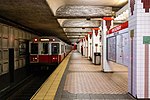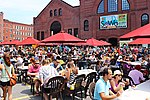Widett Circle

Widett Circle is a locale in Boston, Massachusetts that has long been used as a wholesale food market, but which has been proposed for several redevelopment projects. It is located between a bend in Interstate 93 and the MBTA rail yards, near the Massachusetts Avenue connector to I-93. Widett Circle was named for Attorney Harold Widett who was the Attorney for the meat packers union. Potential uses for the site include: an additional rail layover for the Massachusetts Bay Transportation Authority (MBTA) a trash recycling and transfer facility a new 28,000-seat stadium for the New England Revolution soccer team, though the team's owners are reportedly focusing on a parcel just north of the circle. a floodable watershedThe current occupants have expressed concern that eminent domain proceedings might be used to take their businesses for other uses.
Excerpt from the Wikipedia article Widett Circle (License: CC BY-SA 3.0, Authors, Images).Widett Circle
Dorchester Avenue, Boston South Boston
Geographical coordinates (GPS) Address Nearby Places Show on map
Geographical coordinates (GPS)
| Latitude | Longitude |
|---|---|
| N 42.3392694 ° | E -71.0601283 ° |
Address
MBTA South Side Service & Inspection Facility
Dorchester Avenue 275
02127 Boston, South Boston
Massachusetts, United States
Open on Google Maps







